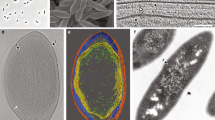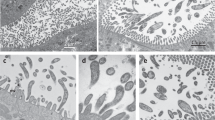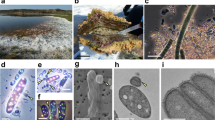Abstract
Many insects rely on bacterial endosymbionts to obtain nutrients that are scarce in their highly specialized diets. The most surprising example corresponds to the endosymbiotic system found in mealybugs from subfamily Pseudococcinae in which two bacteria, the betaproteobacterium ‘Candidatus Tremblaya princeps’ and a gammaproteobacterium, maintain a nested endosymbiotic consortium. In the sister subfamily Phenacoccinae, however, a single beta-endosymbiont, ‘Candidatus Tremblaya phenacola’, has been described. In a previous study, we detected a trpB gene of gammaproteobacterial origin in ‘Ca. Tremblaya phenacola’ from two Phenacoccus species, apparently indicating an unusual case of horizontal gene transfer (HGT) in a bacterial endosymbiont. What we found by sequencing the genome of ‘Ca. Tremblaya phenacola’ PPER, single endosymbiont of Phenacoccus peruvianus, goes beyond a HGT phenomenon. It rather represents a genome fusion between a beta and a gammaproteobacterium, followed by massive rearrangements and loss of redundant genes, leading to an unprecedented evolutionary collage. Mediated by the presence of several repeated sequences, there are many possible genome arrangements, and different subgenomic sequences might coexist within the same population.
Similar content being viewed by others
Log in or create a free account to read this content
Gain free access to this article, as well as selected content from this journal and more on nature.com
or
Accession codes
References
Agashe D, Shankar N . (2014). The evolution of bacterial DNA base composition. J Exp Zool (Mol Dev Evol) 322B: 517–528.
Allen JM, Reed DL, Perotti MA, Braig HR . (2007). Evolutionary relationships of ‘Candidatus Riesia spp.,’ endosymbiotic enterobacteriaceae living within hematophagous primate lice. Appl Environ Microbiol 73: 1659–1664.
Altschul SF, Madden TL, Schaffer AA, Zhang J, Zhang Z, Miller W et al. (1997). Gapped BLAST and PSI-BLAST: a new generation of protein database search programs. Nucleic Acids Res 25: 3389–3402.
Andersson SGE, Zomorodipour A, Andersson JO, Sicheritz-Pontén T, Alsmark UCM et al. (1998). The genome sequence of Rickettsia prowazekii and the origin of mitochondria. Nature 396: 133–140.
Bankevich A, Nurk S, Antipov D, Gurevich AA, Dvorkin M, Kulikov AS et al. (2012). SPAdes: a new genome assembly algorithm and its applications to single-cell sequencing. J Comput Biol 19: 455–477.
Baumann P . (2005). Biology bacteriocyte-associated endosymbionts of plant sap-sucking insects. Annu Rev Microbiol 59: 155–189.
Baumann L, Thao ML, Hess JM, Johnson MW, Baumann P . (2002). The genetic properties of the primary endosymbionts of mealybugs differ from those of other endosymbionts of plant sapsucking insects. Appl Environ Microbio 68: 3198–3205.
Buchner P . (1965) Endosymbiosis of Animals with Plant Microorganisms. Interscience: New York, NY, USA.
Camacho C, Coulouris G, Avagyan V, Ma N, Papadopoulos J, Bealer K et al. (2009). BLAST+: architecture and applications. BMC Bioinformatics 10: 421.
Capella-Gutierrez S, Silla-Martinez JM, Gabaldon T . (2009). trimAl: a tool for automated alignment trimming in large-scale phylogenetic analyses. Bioinformatics 25: 1972–1973.
Carver T, Berriman M, Tivey A, Patel C, Bohme U, Barrell BG et al. (2008). Artemis and ACT: viewing, annotating and comparing sequences stored in a relational database. Bioinformatics 24: 2672–2676.
Chen X, Li S, Aksoy S . (1999). Concordant evolution of a symbiont with its host insect species: molecular phylogeny of genus Glossina and its bacteriome-associated endosymbiont, Wigglesworthia glossinidia. J Mol Evol 48: 49–58.
Comas I, Moya A, Azad RK, Lawrence JG, González-Candelas F . (2006). The evolutionary origin of Xanthomonadales genomes and the nature of the horizontal gene transfer process. Mol Biol Evol 23: 2049–2057.
Conord C, Despres L, Vallier A, Balmand S, Miquel C, Zundel S et al. (2008). Long-term evolutionary stability of bacterial endosymbiosis in curculionoidea: additional evidence of symbiont replacement in the Dryophthoridae family. Mol Biol Evol 25: 859–868.
Duron O . (2013). Lateral transfers of insertion sequences between Wolbachia Cardinium and Rickettsia bacterial endosymbionts. Heredity 2: 1–8.
Finn RD, Bateman A, Clements J, Coggill P, Eberhardt RY, Eddy SR et al. (2014). Pfam: the protein families database. Nucleic Acids Res 42: D222–D230.
Gatehouse LN, Sutherland P, Forgie SA, Kaji R, Christeller JT . (2012). Molecular and histological characterization of primary (betaproteobacteria) and secondary (gammaproteobacteria) endosymbionts of three mealybug species. Appl Environ Microbiol 78: 1187–1197.
Gil R, Silva FJ, Peretó J, Moya A . (2004). Determination of the core of a minimal bacterial gene set. Microbiol Mol Biol Rev 68: 518–537.
Gruwell ME, Hardy NB, Gullan PJ, Dittmar K . (2010). Evolutionary relationships among primary endosymbionts of the mealybug subfamily Phenacoccinae (Hemiptera: Coccoidea: Pseudococcidae). Appl Environ Microbiol 76: 7521–7525.
Guy L, Roat Kultima J, Andersson SGE . (2010). genoPlotR: comparative gene and genome visualization in R. Bioinformatics 26: 2334–2335.
Hardy NB, Gullan PJ, Hodgson CJ . (2008). A subfamily-level classification of mealybugs (Hemiptera: Pseudococcidae) based on integrated molecular and morphological data. Syst Entomol 33: 51–71.
Lin H-H, Liao Y-C . (2016). Accurate binning of metagenomic contigs via automated clustering sequences using information of genomic signatures and marker genes. Sci Rep 6: 24175.
Huerta-Cepas J, Capella-Gutiérrez S, Pryszcz LP, Marcet-Houben M, Gabaldón T . (2014). PhylomeDB v4: zooming into the plurality of evolutionary histories of a genome. Nucleic Acids Res 42: D897–D902.
Houk E, Griffiths GW . (1980). Intracellular symbiotes of Homoptera. Annu Rev Entomol 25: 161–187.
Husnik F, McCutcheon JP . (2016). Repeated replacement of an intrabacterial symbiont in the tripartite nested mealybug symbiosis. Proc Natl Acad Sci USA 113: E5416–E5424.
Husnik F, Nikoh N, Koga R, Ross L, Duncan RP, Fugie M et al. (2013). Horizontal gene transfer from diverse bacteria to an insect genome enables a tripartite nested mealybug symbiosis. Cell 153: 1567–1578.
Huson DH, Beier S, Flade I, Górska A, El-Hadidi M, Mitra S et al. (2016). MEGAN Community edition—interactive exploration and analysis of large-scale microbiome sequencing data. PLoS Comput Biol 12: e1004957.
Kanehisa M, Sato Y, Kawashima M, Furumichi M, Tanabe M . (2016). KEGG as a reference resource for gene and protein annotation. Nucleic Acids Res 44: D457–D462.
Keseler IM, Mackie A, Peralta-Gil M, Santos-Zavaleta A, Gama-Castro S, Bonavides-Martinez C et al. (2013). EcoCyc: fusing model organism databases with systems biology. Nucleic Acids Res 41: D605–D612.
Koga R, Nikoh N, Matsuura Y, Meng X-Y, Fukatsu T . (2012). Mealybugs with distinct endosymbiotic systems living on the same host plant. FEMS Microbiol Ecol 83: 93–100.
Komaki K, Ishikawa H . (1999). Intracellular bacterial symbionts of aphids possess many genomic copies per bacterium. J Mol Evol 48: 717–722.
Kono M, Koga R, Shimada M, Fukatsu T . (2008). Infection dynamics of coexisting beta-and gammaproteobacteria in the nested endosymbiotic system of mealybugs. Appl Environ Microbiol 74: 4175–4184.
Lamelas A, Gosalbes MJ, Manzano-Marín A, Peretó J, Moya A, Latorre A . (2011). Serratia symbiotica from the aphid Cinara cedri: a missing link from facultative to obligate insect endosymbiont. PLoS Genet 7: e1002357.
Latorre A, Manzano-Marín A . (2016). Dissecting genome reduction and trait loss in insect endosymbionts. Ann NY Acad Sci 1389: 52–75.
Li L, Stoeckert CJ Jr, Roos DS . (2003). OrthoMCL: identification of ortholog groups for eukaryotic genomes. Genome Res 13: 2178–2189.
Lo N, Bandi C, Watanabe H, Nalepa C, Beninati T . (2003). Evidence for cocladogenesis between diverse dictyopteran lineages and their intracellular endosymbionts. Mol Biol Evol 20: 907–913.
López-Madrigal S, Beltrà A, Resurrección S, Soto A, Latorre A, Moya A et al. (2014). Molecular evidence for ongoing complementarity and horizontal gene transfer in endosymbiotic systems of mealybugs. Front Microbiol 5: 449.
López-Madrigal S, Latorre A, Moya A, Gil R . (2015). The link between independent acquisition of intracellular gamma-endosymbionts and concerted evolution in Tremblaya princeps. Front Microbiol 6: 642.
López-Madrigal S, Latorre A, Porcar M, Moya A, Gil R . (2011). Complete genome sequence of ‘Candidatus Tremblaya princeps’ strain PCVAL, an intriguing translational machine below the living-cell status. J Bacteriol 193: 5587–5588.
López-Madrigal S, Latorre A, Porcar M, Moya A, Gil R . (2013). Mealybugs nested endosymbiosis: going into the ‘matryoshka’ system in Planococcus citri in depth. BMC Microbiol 13: 74.
Luan J-B, Chen W, Hasegawa DK, Simmons AM, Wintermantel WM, Ling K-S et al. (2015). Metabolic coevolution in the bacterial symbiosis of whiteflies and related plant sap-feeding insects. Genome Biol Evol 7: evv170.
Magoc T, Salzberg S . (2011). FLASH: Fast length adjustment of short reads to improve genome assemblies. Bioinformatics 27: 2957–2963.
Manzano-Marín A, Simon JC, Latorre A . (2016). Reinventing the wheel and making it round again: evolutionary convergence in Buchnera–Serratia symbiotic consortia between the distantly related Lachninae aphids Tuberolachnus salignus and Cinara cedri. Genome Biol Evol 8: 1440–1458.
Maréchal A, Brisson N . (2010). Recombination and the maintenance of plant organelle genome stability. New Phytol 186: 299–317.
Martin M . (2011). Cutadapt removes adapter sequences from high-throughput sequencing reads. EMBnet J 17: 10–12.
McCutcheon JP, Moran NA . (2012). Extreme genome reduction in symbiotic bacteria. Nat Rev Microbiol 10: 13–26.
McCutcheon JP, von Dohlen CD . (2011). An interdependent metabolic patchwork in the nested symbiosis of mealybugs. Curr Biol 21: 1366–1372.
McFall-Ngai M . (2008). Are biologist in ‘future shock?’ Symbiosis integrates biology across domains. Nat Rev Microbiol 6: 789–792.
Moya A, Peretó J, Gil R, Latorre A . (2008). Learning how to live together: genomic insights into prokaryote-animal symbioses. Nat Rev Genet 9: 218–229.
Moran NA . (1996). Accelerated evolution and Muller’s rachet in endosymbiotic bacteria. Proc Natl Acad Sci USA 93: 2873–2878.
Moran NA, Dale C, Dunbar H, Smith WA, Ochman H . (2003). Intracellular symbionts of sharpshooters (Insecta: Hemiptera: Cicadellinae) form a distinct clade with a small genome. Environ Microbiol 5: 116–126.
Mori M, Ponce-de-León M, Peretó J, Montero F . (2016). Metabolic complementation in bacterial communities: necessary conditions and optimality. Front Microbiol 7: 1553.
Munson MA, Baumann P, Clark MA, Baumann L, Moran NA, Voegtlin DJ et al. (1991). Evidence for the establishment of aphid-eubacterium endosymbiosis in an ancestor of four aphid families. J Bacteriol 173: 6321–6324.
Munson MA, Baumann P, Moran NA . (1992). Phylogenetic relationships of the endosymbionts of mealybugs (Homoptera: Pseudococcidae) based on 16S rDNA sequences. Mol Phylogenet Evol 1: 26–30.
Murray RG, Schleifer KH . (1994). Taxonomic notes: a proposal for recording the properties of putative taxa of procaryotes. Int J Syst Bacteriol 44: 174–176.
Nakabachi A, Ueoka R, Oshima K, Tet R, Mangoni A, Gurgui M et al. (2013). Defensive bacteriome symbiont with a drastically reduced genome. Curr Biol 23: 1478–1484.
Niko N, Hosokawa T, Moriyama M, Oshima K, Hattori M, Fukatsu T . (2014). Evolutionary origin of insect–Wolbachia nutritional mutualism. Proc Natl Acad Sci USA 111: 10257–10262.
Oakeson KF, Gil R, Clayton AL, Dunn DM, von Niederhausern AC, Hamil C et al. (2014). Genome degeneration and adaptation in a nascent stage of symbiosis. Genome Biol Evol 6: 76–93.
O'Leary NA, Wright MW, Brister JR, Ciufo S, Haddad D, McVeigh R et al. (2016). Reference sequence (RefSeq) database at NCBI: current status, taxonomic expansion, and functional annotation. Nucleic Acids Res 44 (D1): D733–D745.
Rice DW, Alverson AJ, Richardson AO, Young GJ, Sanchez-Puerta MV, Munzinger J et al. (2013). Horizontal transfer of entire genomes via mitochondrial fusion in the angiosmerp Amborella. Science 342: 1468–1473.
Rocha E . (2004). The replication-related organization of bacterial genomes. Microbiology 150: 1609–1627.
Rocha E . (2008). The organization of the bacterial genome. Annu Rev Genet 42: 211–233.
Rosenblueth M, Sayavedra L, Sámano-Sánchez H, Roth A, Martínez-Romero E . (2012). Evolutionary relationships of flavobacterial and enterobacterial endosymbionts with their scale insect hosts (Hemiptera: Coccoidea). J Evol Biol 25: 2357–2368.
Sanchez-Puerta MV . (2014). Involvement of plastid, mitochondrial and nuclear genomes in plant-to-plant horizontal gene transfer. Acta Soc Bot Pol 83: 317–323.
Sauer C, Stackebrandt E, Gadau J, Hölldobler B, Gross R . (2000). Systematic relationships and cospeciation of bacterial endosymbionts and their carpenter ant host species: proposal of the new taxon Candidatus Blochmannia gen. nov. Int J Syst Evol Microbiol 50: 1877–1886.
Seemann T . (2014). Prokka: rapid prokaryotic genome annotation. Bioinformatics 30: 2068–2069.
Segata N, Börnigen D, Morgan XC, Huttenhower C . (2013). PhyloPhlAn is a new method for improved phylogenetic and taxonomic placement of microbes. Nat Commun 4: 2304.
Shannon P, Markiel A, Ozier O, Baliga NS, Wang JT, Ramage D et al. (2003). Cytoscape: a software environment for integrated models of biomolecular interaction networks. Genome Res 13: 2498–2504.
Siguier P, Perochon J, Lestrade L, Mahillon J, Chandler M . (2006). ISfinder: the reference centre for bacterial insertion sequences. Nucleic Acids Res 34: D32–D36.
Sloan DB, Moran NA . (2012). Genome reduction and co-evolution between the primary and secondary bacterial symbionts of psyllids. Mol Biol Evol 29: 3781–3792.
Sloan DB, Nakabachi A, Richards S, Qu J, Murali SC, Gibbs RA et al. (2014). Parallel histories of horizontal gene transfer facilitated extreme reduction of endosymbiont genomes in sap-feeding insects. Mol Biol Evol 31: 857–871.
Staden R, Beal KF, Bonfield JK . (2000). The Staden package, 1998. Methods Mol Biol 132: 115–130.
Stamatakis A . (2014). RAxML version 8: a tool for phylogenetic analysis and post-analysis of large phylogenies. Bioinformatics 30: 1312–1313.
Szabó G, Schulz F, Toenshoff ER, Volland J-M, Finkel OM, Belkin S et al. (2017). Convergent patterns in the evolution of mealybug symbioses involving different intrabacterial symbionts. ISME J 11: 715–726.
Thao ML, Baumann P . (2004). Evolutionary relationships of primary prokaryotic endosymbionts of whiteflies and their hosts. Appl Environ Microbiol 70: 3401–3406.
Thao ML, Moran NA, Abbot P, Brennan EB, Burckhardt DH, Baumann P . (2000). Cospeciation of psyllids and their primary prokaryotic endosymbionts. Appl Environ Microbiol 66: 2898–2905.
Untergasser A, Cutcutache I, Koressaar T, Ye J, Faircloth BC, Remm M et al. (2012). Primer3—new capabilities and interfaces. Nucleic Acids Res 40: e115.
van Ham RCHJ, Kamerbeek J, Palacios C, Rausell C, Abascal F, bastolla U et al. (2003). Reductive genome evolution in Buchnera aphidicola. Proc Natl Acad Sci USA 100: 581–586.
van Leuven JT, Meister RC, Simon C, McCutcheon JP . (2014). Sympatric speciation in a bacterial endosymbiont results in two genomes with the functionality of one. Cell 158: 1270–1280.
von Dohlen CD, Kohler S, Alsop ST, McManus WR . (2001). Mealybug β-proteobacterial endosymbionts contain γ-proteobacterial symbionts. Nature 412: 433–436.
Woyke T, Tighe D, Mavromatis K, Clum A, Copeland A, Schackwitz W et al. (2010). One bacterial cell, one complete genome. PLoS One 5: e10314.
Acknowledgements
We thank Dr Antonia Soto (Universitat Politècnica de València) for biological samples supply; Dr Iñaki Comas, Galo Goig and Manuela Torres-Puente (Institut de Biomedicina de València) for help with Nanopore sequencing. This work was supported by grants BFU2015-64322-C2-1-R (co-financed by FEDER funds and Ministerio de Economía y Competitividad, Spain) and PrometeoII/2014/065 (Generalitat Valenciana, Spain). CVC is a recipient of a fellowship from the Ministerio de Economía y Competitividad (Spain).
Author information
Authors and Affiliations
Corresponding author
Ethics declarations
Competing interests
The authors declare no conflict of interest.
Additional information
Supplementary Information accompanies this paper on The ISME Journal website
Supplementary information
Rights and permissions
About this article
Cite this article
Gil, R., Vargas-Chavez, C., López-Madrigal, S. et al. Tremblaya phenacola PPER: an evolutionary beta-gammaproteobacterium collage. ISME J 12, 124–135 (2018). https://doi.org/10.1038/ismej.2017.144
Received:
Revised:
Accepted:
Published:
Issue date:
DOI: https://doi.org/10.1038/ismej.2017.144
This article is cited by
-
Comprehensive review of the microbial approach to Mealybug management
International Journal of Tropical Insect Science (2025)
-
Molecular characterization, ultrastructure, and transovarial transmission of Tremblaya phenacola in six mealybugs of the Phenacoccinae subfamily (Insecta, Hemiptera, Coccomorpha)
Protoplasma (2019)



